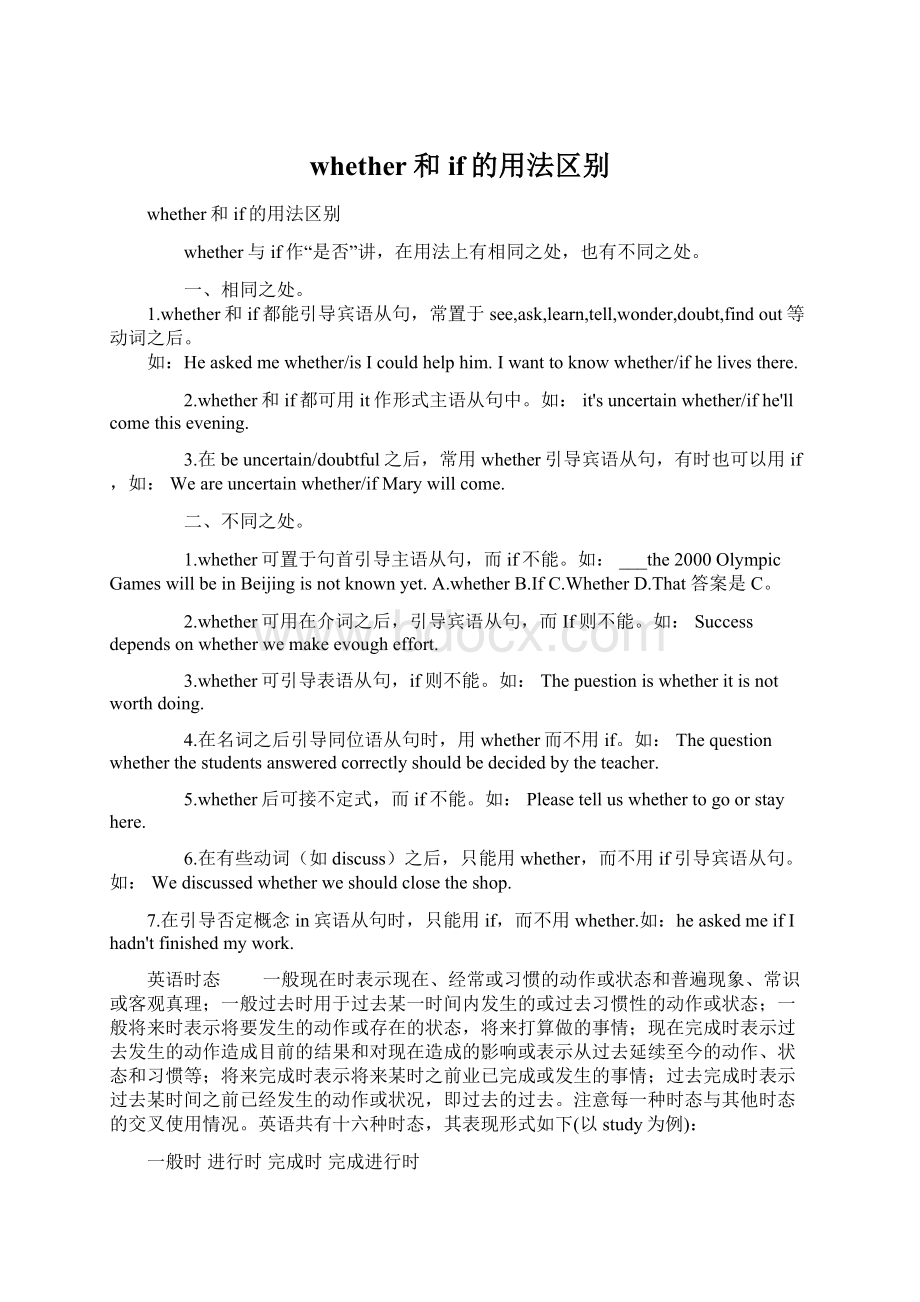 whether和if的用法区别文档格式.docx
whether和if的用法区别文档格式.docx
- 文档编号:21696463
- 上传时间:2023-01-31
- 格式:DOCX
- 页数:94
- 大小:111.46KB
whether和if的用法区别文档格式.docx
《whether和if的用法区别文档格式.docx》由会员分享,可在线阅读,更多相关《whether和if的用法区别文档格式.docx(94页珍藏版)》请在冰豆网上搜索。

Pleasetelluswhethertogoorstayhere.
6.在有些动词(如discuss)之后,只能用whether,而不用if引导宾语从句。
Wediscussedwhetherweshouldclosetheshop.
7.在引导否定概念in宾语从句时,只能用if,而不用whether.如:
heaskedmeifIhadn'
tfinishedmywork.
英语时态
一般现在时表示现在、经常或习惯的动作或状态和普遍现象、常识或客观真理;
一般过去时用于过去某一时间内发生的或过去习惯性的动作或状态;
一般将来时表示将要发生的动作或存在的状态,将来打算做的事情;
现在完成时表示过去发生的动作造成目前的结果和对现在造成的影响或表示从过去延续至今的动作、状态和习惯等;
将来完成时表示将来某时之前业已完成或发生的事情;
过去完成时表示过去某时间之前已经发生的动作或状况,即过去的过去。
注意每一种时态与其他时态的交叉使用情况。
英语共有十六种时态,其表现形式如下(以study为例):
一般时进行时完成时完成进行时
现在studystudiesamstudyingisstudyingarestudyinghavestudied
hasstudiedhavebeenstudyinghasbeenstudying
过去studiedwasstudyingwerestudyinghadstudiedhadbeenstudying
将来shallstudywillstudyshallbestudyingwillbestudyingshallhavestudied
willhavestudiedshallhavebeenstudyingwillhavebeenstudying
过去将来shouldstudywouldstudyshouldbestudyingwouldbestudying
shouldhavestudiedwouldhavestudiedshouldhavebeenstudyingwouldhavebeenstudying
但考试中出现的一般有以下几种。
第一节一般现在时
一、表示一般性或经常发生的动作或状态
二、表示习惯性动作和状态或普遍的现象或常识
三、表示客观事实、客观规律和客观真理。
在宾语从句中,即使主句的谓语动词用了过去时,只要从句表示的是客观真理,从句的谓语动词也要用一般现在时
四、祈使句必须用动词原形,其否定结构用“don`t+动词原形”,如:
Goandfetchsomewater./Don`tdothat.
五、在反义疑问句中,如果主句用肯定句,那么,反问句用否定形式;
如果主句用否定形式,那么,反问句就用肯定形式。
而且前后在时态上要一致。
但祈使疑问句用won`tyou?
进行反问。
Seeafilmtonight,won`tyou?
注:
①祈使句后边可用附加疑问句,以加强语气。
如果祈使句用肯定形式,附加疑问句用否定形式;
如果祈使句用否定形式,附加句用肯定形式;
ComeherenextSunday,won`tyou?
/Don`ttellittoanyone,willyou?
②但如果祈使句的前一句有了表示强烈肯定的语言环境,即使祈使句用了肯定形式,其附加成分也可以用“willyou”(表示肯定,如果是在口语中用降调)。
Givemethebook,willyou?
第二节一般过去时
一、一般过去时主要表示过去某一时刻发生的动作或情况,句中通常有表示过去某一时刻的状语adayago,lastweek,in1996,duringthenight,inanceinttimes等,表示“过多少时间之后”用after,但在现在完成时中用in,如inthepastfewyears等
第三节一般将来时
一、一般将来时表示将要发生的动作或状况
二、在表示时间和条件的状语从句中,一般现在时代替一般将来时。
这些时间副词有when,assoonas等,表示条件的连词有if,aslongas等
三、一些表示方向及变化的瞬间动词可用进行时或现在时表示将要发生的动作
Weleave(areleaving)forCaliforniathedayaftertomorrow.我们(计划)后天动身去加利福尼亚州。
MayIhaveyourattentionplease.TheplaneforWuhanisabouttotakeoff.请注意,飞往武汉的飞机就要起飞了。
四、另外,“be+to+动词原形”也可表示打算做的事,还可表示责任、意向和可能性
Youaretofollowthedoctor’sadvice.你应遵从医嘱。
Noshelterwastobeseen.找不到避难处。
第四节现在完成时
一、现在完成时的构成式是have(has)+动词的ED分词
二、现在完成时表示到现在为止的一段时间内发生的情况或动作,强调的是对现在的影响,可能是已完成的动作,也可表示多次动作的总和,或习惯性的行为和持续的动作
三、如果句中有表示到现在为止这段时间的状语时,用现在完成时,这些时间状语有now,today,thisweek,thismonth,thisyear,现在完成时不和表示具体的时间状语连用,如yesterday,lastyear等,但可以和always,before,just,in/duringthepast(fewweeks,years,fiftyyears)连用,这时in表示“过去多少时间”,不能用after
四、在有already,asyet,yet,ever,just,never这类副词作状语的情况下,用现在完成时
五、有“since+时间点,for+一段时间”引导的状语时,主句谓语用现在完成时态
11)JekyllIslandhasbeenone[A]ofGeorgia’sstate[B]parks[C]in[D]1954.
12)Heis[A]inthiscountrynow[B]forfiveyears,buthemakes[C]noattempttospeak[D]ourlanguage.
13)TheBrowns[A]arelivingahard[B]lifebecauseMr.Brownhasbeenunemployed[C]since[D]halfayear.
六、现在完成时用于将来的情况,即主语为一般将来时,时间和条件从句中的谓语用现在完成时(而不能用将来完成时)表示将来某时完成的动作
第五节将来完成时和过去完成时
一、将来完成时表示将来某时业已发生的动作和情况,或已经存在的状态
二、过去完成时表示在过去某一时刻之前业已发生了的动作或现象,句中通常会出现有表示过去某一时刻的时间状语
第六节进行时态
一、现在进行时表示现在或现阶段进行的动作,但也和always,constantly,forever等频度副词连用表示一个经常进行的动作或现在存在的状态
二、瞬间动词和一些表示状态及感觉的动词一般不用进行时,而用一般现在时或一般过去时代替。
这些动词包括:
appear(显然),arrive,be,come,desire,go,find,hate,hope,join,know,leave,like,love,join,possess,start,sail,see,suggest,taste,think(认为),understand等,类似的动词还有belongto,consistof,seem(似乎)等
三、过去完成进行时
过去完成进行时表示到过去的某一时间点或某一时间段里一直在进行的动作或行为
5)Theyreceivedtheparcelthattheyforalongtime.
[A]expected[B]haveexpected[C]hadbeenexpecting[D]hadexpected
ThereisawellknownincidentinoneofMoliere′splays,wheretheauthormakestheheroexpressunboundeddelightonbeingtoldthathehadbeentalkingproseduringthewholeofhislife.(93年翻译)
四、例题解析
1)D错。
slow只有作为不及物动词用时才与up或down连用,表示“慢慢向上”或“慢慢向下”。
所以我们说,这里的slow是动词而不是形容词,应将动词slow后边加上“ing”,改为(is)slowingdown,构成现在进行时。
2)C错,改为are。
3)A错,改为saw。
4)D错,改为are。
5)C为正确答案。
英语高考专题复习讲与练(17)反意疑问句
反意疑问句是英语四大问句之一,它是由一个陈述句加上一个短问句而构成的。
反意疑问句的基本构成形式是:
陈述句+动词(肯定或否定)+主语?
①Sheoftenhaslunchatschool,doesn’tshe?
②Youdon’tlikesports,doyou?
使用反意疑问句要注意以下若干对应规则:
一、反意疑问句中问句部分的动词与陈述部分的动词在语气上成相反的对应关系,即:
肯定+否定?
否定+肯定?
①Youcan’tdoit,canyou?
②Theyareverylateforthemeeting,aren’tthey?
二、反意疑问句中问句部分的动词与陈述部分的动词种类要对应一致。
①Hehassupperathomeeveryday,doesn’the?
(不能用hasn’the?
)
②Theyhaveknownthematter,haven’tthey?
(不能用don’tthey?
三、反意疑问句中问句部分的动词在时态上应和陈述部分的时态一致。
①Theywillgototownsoon,won’tthey?
(不能用don’tthey?
或aren’tthey?
②Heworksveryhard,doesn’the?
(不能用didn’the?
或won’the?
四、反意疑问句的陈述部分含有由un-,im-,in-,dis-,等否定意义的前缀构成的词语时,陈述部分要视为肯定含义,问句部分用否定形式。
①Yourfatherisunhappy,isn’the?
(不能用ishe?
②Themanisdishonest,isn’the?
(不能用ishe?
③ItisimpossibletolearnEnglishwithoutrememberingmorewords,isn’tit?
(不能用isit?
五、反意疑问句的陈述部分带有little,few,never,hardly,seldom等否定意义的词时,问句部分用肯定式。
①Shenevertellsalie,doesshe?
(不用doesn’tshe?
②Hewasseldomlate,washe?
(不用wasn’the?
六、反意疑问句的陈述部分为Iam……时,问句部分习惯上用aren’tI?
表示。
Iamaveryhonestman,aren’tI?
七、反意疑问句的陈述部分为I(We)think(believe,suppose,consider)+that从句时,问句部分的动词及主语与that从句内的动词和主语保持一致。
①Ithinkthathehasdonehisbest,hasn’the?
②WethinkthatEnglishisveryuseful,isn’tit?
(不用don’twe?
八、反意疑问句的陈述部分为I(We)don’tthink(believe,suppose,consider)+that从句时,从句为否定意义,问句部分的动词和主语仍与that从句保持一致且用肯定式。
①Idon’tthinkthatyoucandoit,canyou?
(不用doI?
②Wedon’tbelievethatthenewsistrue,isit?
(不用dowe?
九、反意疑问句的陈述部分为非第一人称主语+think(believe,suppose,consider)+that从句时,问句部分的动词和主语与陈述部分的主句动词和主语保持一致。
①TheyallthinkthatEnglishisveryimportant,don’tthey?
(不用isn’tit?
②Hedidn’tthinkthatthenewswastrue,didhe?
(不用wasn’t/wasit?
十、反意疑问句的陈述部分为主语+said(told,reported,asked……)+that从句时,问句部分的动词和主语与陈述部分的主句动词和主语保持一致。
①Theysaidthatyouhadfinishedyourwork,didn’tthey?
(不用hadn’tyou)
②Katetoldyouthatshewouldgothere,didn’tshe?
(不用wouldn’tshe?
十一、陈述部分的主语为不定代词something,anything,nothing,everything时,问句部分的主语用it。
①Somethingiswrongwiththecomputer,isn’tit?
②Nothinghashappenedtothem,hasit?
十二、陈述部分的主语为不定代词somebody(someone),anybody(anyone),nobody(noone),everybody(everyone)时,问句部分的主语用he或they,这时问句动词的数应和he或they一致。
①Someonehastakentheseat,hasn’the?
②Everyonehasdonetheirbestinthegame,haven’tthey?
十三、陈述部分为Letme……时,问句部分习惯上用shallI?
或willyou?
形式。
Letmehaveatry,shallI?
(willyou?
十四、陈述部分为Letus……时,问句部分习惯上用willyou?
Letusstoptorest,willyou?
十五、陈述部分为Let’s……时,问句部分习惯上用shallwe?
Let’sgohometogether,shallwe?
十六、陈述部分用上述情况以外的祈使句时,问句部分一般用willyou?
形式表示请求,用won’tyou?
形式表示委婉请求或邀请。
①Dositdown,won’tyou?
/willyou?
②Youfeedthebirdtoday,willyou?
③Pleaseopenthewindow,willyou?
(won’tyou?
十七、陈述部分为否定祈使句时,问句部分一般用willyou?
Don’tmakeanynoise,willyou?
十八、陈述部分为There(Here)+be+主语时,问句部分用动词+there(here)?
①Therearetwocakesontheplate,aren’tthere?
②HereisastoryaboutMarkTwain,isn’there?
十九、陈述部分用hadbetter+原形动词表示建议时,问句部分用hadn’t+主语?
①You’dbettertellhimaboutthematter,hadn’tyou?
②Wehadbetterdoitbyourselves,hadn’twe?
二十、陈述部分用usedto+主语时,问句部分用didn’t+主语?
或usedn’t+主语?
①Heusedtoliveinthecountry,didn’the?
/usedn’the?
②Theyusedtobegoodfriends,didn’tthey?
/usedn’tthey?
二十一、陈述部分用must(may,might)+have+V-ed表示推测时,若句中带有明显的过去时间的状语,问句部分动词用过去时形式。
①Hemighthaveforgottenhispenintheclassroomyesterday,didn’the?
(不用mightn’the?
/hasn’the?
②Youmusthavegotuplatethismorning,didn’tyou?
(不用mustn’tyou?
/haven’tyou?
二十二、陈述部分用must(may,might)+have+V-ed表示推测时,若句中没有带明显的过去时间的状语,问句部分动词用现在完成时形式。
①Everyonemusthaveknownthedeathofthewaitress,haven’tthey?
(不用mustn’tthey?
②Youmusthaveworkedthereayearago,didn’tyou?
/haven’tyou?
二十三、陈述部分的主语为从句时,问句部分的主语一般用it代替,如:
①Whathesaidistrue,isn\'
tit?
(不用didn’the?
②Wherewewillbuildthedamhasnotbeendecidedyet,hasit?
(不用won’twe?
二十四、陈述部分的主语为动名词或不定式时,问句的主语用it代替。
①Todoonegooddeediseasyforaperson,isn\'
②Skatingisyourfavoritesport,isn\'
反意疑问句专题练习
1.Ithinktheywillgototowntomorrow,________?
A.doIB.don’tIC.willtheyD.won’tthey
2.Idon’tbelievehecancatchupwithme,_________?
A.canheB.can’theC.doID.don’tI
3.I’msurethatIwillbewellagain,__________?
A.amIB.aren’tIC.willID.won’tI
4.Iamafraidthathewillnotcome,_______?
A.amIB.aren’tIC.willheD.won’the
5.Theydon’tbelieveyouarewrong,_________?
A.areyouB.aren’tyouC.dotheyD.don’tthey
6.HethoughtyouwereBeijing,_________?
A.didn’theB.didheC.weren’tyouD.wereyou
7.Wetoldyouthathewouldcometonight,_______?
A.didn’tweB.didweC.wouldheD.wouldn’the
8.Thereportersaidthenewswasnottrue,_______
- 配套讲稿:
如PPT文件的首页显示word图标,表示该PPT已包含配套word讲稿。双击word图标可打开word文档。
- 特殊限制:
部分文档作品中含有的国旗、国徽等图片,仅作为作品整体效果示例展示,禁止商用。设计者仅对作品中独创性部分享有著作权。
- 关 键 词:
- whether if 用法 区别
 冰豆网所有资源均是用户自行上传分享,仅供网友学习交流,未经上传用户书面授权,请勿作他用。
冰豆网所有资源均是用户自行上传分享,仅供网友学习交流,未经上传用户书面授权,请勿作他用。


 广东省普通高中学业水平考试数学科考试大纲Word文档下载推荐.docx
广东省普通高中学业水平考试数学科考试大纲Word文档下载推荐.docx
